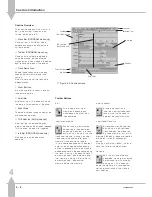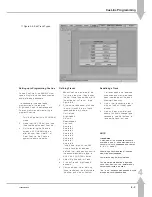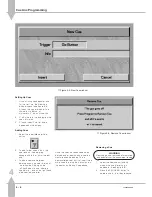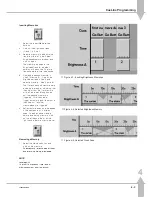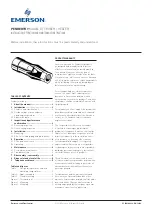
Internal Memory Structure
During the course of normal operation,
there is no need for the operator to be
aware of the different types of memory
and data in the desk. Nor does
anything need to be done to protect
data, apart from the operator making
normal backups to floppy disk as a
precaution against the desk being
stolen, for example.
However, for information, there follows
an overview of how the data is handled
and stored by the desk.
The desk holds several types of data:
desk operating system software, fixture
data files (Zero 88 fixture and user
fixture files), desk set-up data, lighting
data (memories) and CueLine data.
The above types of data are stored in
four areas: volatile dynamic RAM,
battery backed static RAM, flash RAM
and floppy disk.
A floppy disk is only used to back up
existing data or to introduce new data
to the desk.
Volatile dynamic RAM is only used by
the desk operating system to speed up
the desk operation, not to store lighting
data.
Battery backed static RAM is very
quick to write to and read back from,
but it is not large.
Flash RAM is a very safe electronic
medium for storing data, with very little
chance of any data that is written to it
being lost. However, although it is
quick to read from, it has the
disadvantage of being fairly slow to
write to.
All desk operating software and fixture
data files are held in flash RAM. Desk
set-up data comprises the current
show name, the fixture data files for
those fixture types currently used, the
allocation of fixtures to desk channels
and DMX start address, and other
information, and is also stored in flash
RAM. Memories are stored initially in
battery backed static RAM. If a show is
large enough, it is moved to flash RAM.
Further memories programmed are
then periodically updated to flash RAM
automatically.
When the show is saved to floppy disk,
all desk set-up and lighting data is
saved, together with the fixture data
files used in the show.
If the desk is in an installation where
the rig does not change very much, but
many different shows are performed, it
is advisable to create a show called
Basic Rig with all fixtures and start
addresses allocated and a few basic
memories recorded, and to save it to a
floppy disk. This can then be reloaded
before creating a new show both to
allow rig testing and to provide a
known starting point.
Controls
l
WHEELS
Used to adjust fixture parameter levels.
l
WHEEL DISPLAY
Guides the operator on which wheel to
use for which parameter.
l
PROGRAM BUTTON
Commits the current settings to
electronic memory.
l
MEMORY DISPLAY
Guides the operator step by step
through the menus.
l
ARROW KEYS
Use to scroll through the menus.
Shown as []{} keys throughout the
manual. If an external keyboard is
used, the cursor keys have the same
function.
l
FLASH FUNCTION BUTTON
Modifies the function of the channel
flash buttons, enabling text entry and
fixture selection, as indicated by the
adjacent light. When setting up the
desk, the FLASH and SOLO functions
are disabled.
l
CHANNEL FLASH BUTTONS
Have two functions in PROGRAM
mode: selecting fixtures; entering text.
/p5-2/3
l
SHIFT BUTTON
Accesses the second row of text
characters on the channel flash buttons
and accessing Fixture 48 to 96 (25 to
48) in Wide Mode.
l
AUXILIARY (AUX CONTROL)
BUTTONS
Can be programmed to
activate/deactivate predefined DMX
channels.
Navigating SetUp
The SetUp section of the desk is split
into six areas, as follows:
FILES
Controls saving of data and loading to
floppy disk.
ILLUMINATION
Allows the setting of litlite levels, desk
light (LED) brightness, LCD backlight
brightness and contrast.
DESK SETUP
Sets up the desk default values and
assigns fixtures to channels and DMX
start addresses.
FIXTURE SETUP
Allows the operator to create or modify
fixture files.
STAGE SETUP
(Not yet implemented.)
FIXTURE CONTROL
(Not yet implemented.)
Allows remote lamp on/lamp off and
reset for intelligent fixtures, assuming
the fixture has those functions.
5
Setting Up the Desk
5 - 2
7364000/p5-2/3
Summary of Contents for SIRIUS 500
Page 1: ...SIRIUS 500 250 OPERATOR S MANUAL...
Page 3: ...ii...
Page 7: ...Pvi V3 TABLE OF CONTENTS vi 7364000 Pvi V3...
Page 15: ......
Page 30: ...p3 11 3 7364000 p3 11 3 3 11...
Page 57: ......
Page 67: ...p4 10 1...
Page 107: ......
Page 111: ......
Page 117: ......





